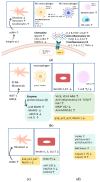Systematic Review on Working Mechanisms of Signaling Pathways in Fibrosis During Shockwave Therapy
- PMID: 39519292
- PMCID: PMC11546838
- DOI: 10.3390/ijms252111729
Systematic Review on Working Mechanisms of Signaling Pathways in Fibrosis During Shockwave Therapy
Abstract
Fibrosis is characterized by scarring and hardening of tissues and organs. It can affect every organ system, and so could result in organ failure due to the accumulation of extracellular matrix proteins. Previous studies suggest that mechanical forces (such as shockwave therapy, SWT) initiate a process of mechanotransduction and thus could regulate fibrosis. Nevertheless, it is largely unexamined which pathways are exactly involved in the application of SWT and can regulate fibrosis. The present article seeks to elucidate the underlying effect of SWT on fibrosis. Evidence shows that SWT activates macrophage activity, fibroblast activity, collagen amount and orientation and apoptosis, which ultimately lead to an adaptation of inflammation, proliferation, angiogenesis and apoptosis. The included articles reveal that other proteins and pathways can be activated depending on the energy levels and frequency of SWT. These findings demonstrate that SWT has beneficial effects on fibrosis by influencing the proteins and pathways. Based on these data, which highlights the underlying mechanisms, we can make preliminary conclusions about the treatment modalities of SWT in scar formation, such as the energy levels and frequencies that are necessary to prevent or treat fibrotic tissue.
Keywords: fibrosis; shockwave therapy; underlying mechanisms.
Conflict of interest statement
The authors declare no conflicts of interest.
Figures




References
-
- Aschermann I., Noor S., Venturelli S., Sinnberg T., Busch C., Mnich C.D. Extracorporal Shock Waves Activate Migration, Proliferation and Inflammatory Pathways in Fibroblasts and Keratinocytes, and Improve Wound Healing in an Open-Label, Single-Arm Study in Patients with Therapy-Refractory Chronic Leg Ulcers. Cell. Physiol. Biochem. 2017;41:890–906. doi: 10.1159/000460503. - DOI - PubMed
Publication types
MeSH terms
Grants and funding
LinkOut - more resources
Full Text Sources

